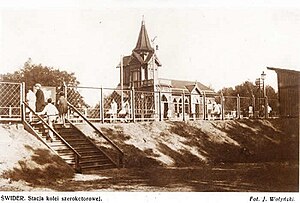Kraplanka


Kraplanka is an architectural style developed in Bistravia in the late 19th century on the coast of Lake Min. Applied mostly to villas and residences of the upper class, it incorporates elements of the local Bistravian rural architecture, Soravian cottages, as well as mountain shelters found in the Neeves, especially in Valduvia and Werania. It was developed by Martin Voják, a Bistravian sculptor and painter in the second half of the 19th century, following his travels around Euclea.
Origins
The name Kraplanka literally means "a waterdrop", although the origin of the name is disputed. It most probably refers to the steep shape of roofing, inspired by housing styles in more mountainous areas of Euclea, where it was common to raise buildings with tall roofs as to enable snow and rain to slide down. In the Bistravian literature the style can be also referred to as Uězérny stil (bi. Уєзéрни стіљ), meaning simply Lake style. The term became more common at the beginning of the 21st century during the revival of the design.
The architectural style was developed by Martin Voják, a Soravian-born Bistravian. Voják was born in 1866 in Králjovice and later studied Arts at the Soravian Art Academy (present day National Art Academy of Bistravia) there. Voják's initial interest were sculpture and painting, however he would quickly discover his passion towards architectural sketches during numerous travels to Lake Min, where his family owned a summer residence near Tbrýž (currently Biškóvě).